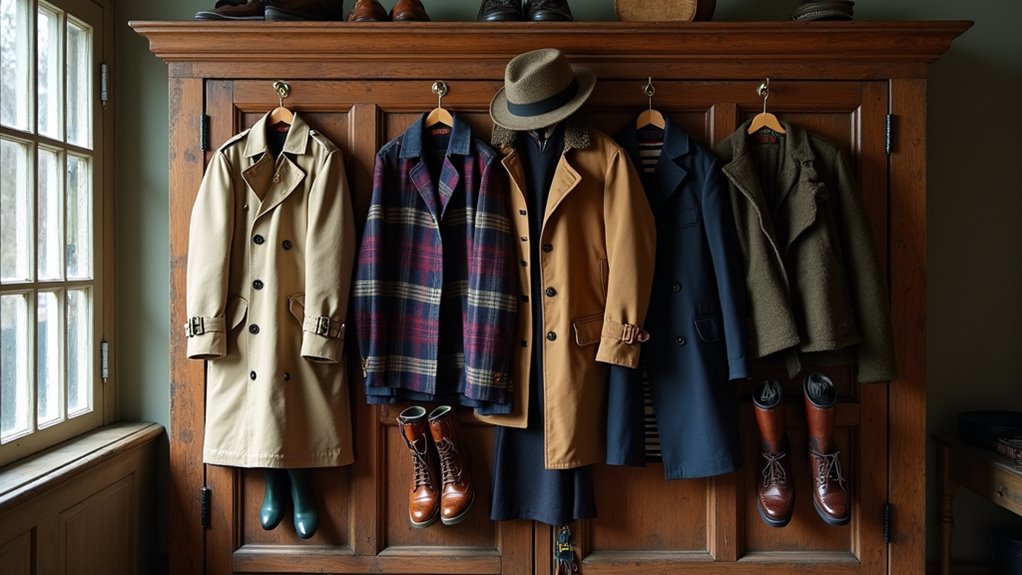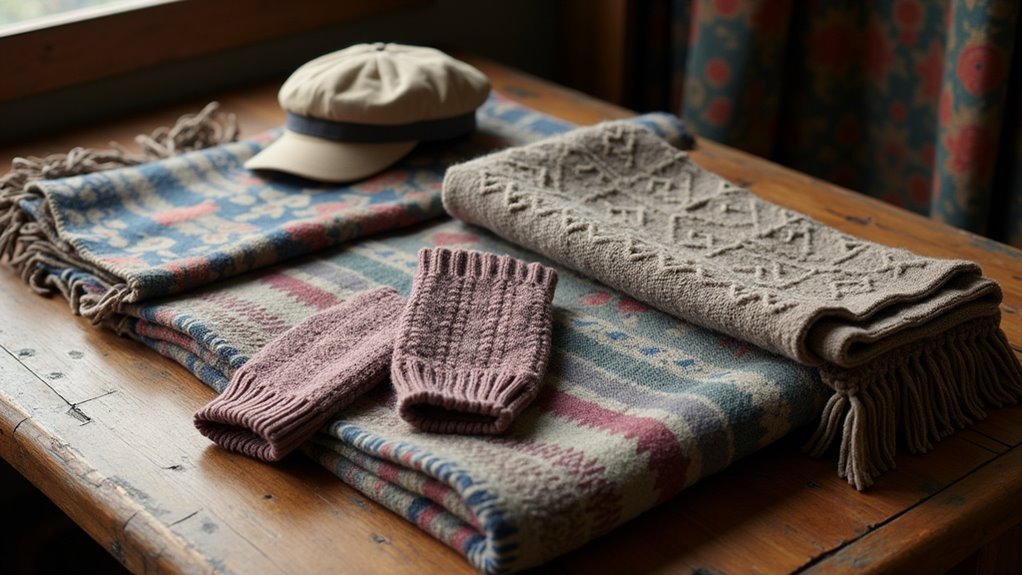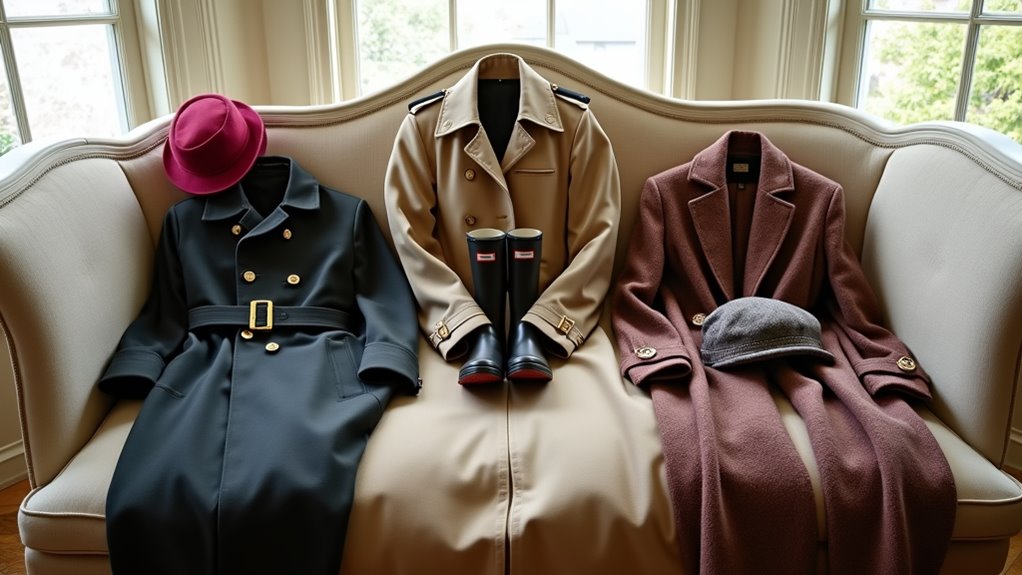Physical Address
304 North Cardinal St.
Dorchester Center, MA 02124
Physical Address
304 North Cardinal St.
Dorchester Center, MA 02124

From tweed jackets to Highland kilts, these nine iconic British garments reveal centuries of style, tradition and royal influence.
Picture yourself strolling through the misty Yorkshire countryside, where timeless British fashion comes alive in every hedgerow and historic manor. You’ll find that British clothing culture goes far beyond the stereotypical bowler hat and umbrella. It’s a world where heritage meets functionality, where each garment tells a story of craftsmanship and tradition. From the Highland kilts of Scotland to the distinctive Welsh wool patterns, you’re about to discover nine essential pieces that have shaped Britain’s sartorial identity.

While the tweed jacket serves as an enduring symbol of British countryside fashion, its origins trace back to Scotland and Ireland’s practical workwear. You’ll find this durable fabric showcasing classic patterns like herringbone and houndstooth, typically in earthy tones that blend with rural landscapes.
What makes tweed truly special is its remarkable functionality. You’re getting a garment that’s weather-resistant, insulating, and surprisingly comfortable despite its robust nature. The fabric’s thick, felted texture protects you from cold and wet conditions, making it ideal for outdoor activities. The iconic Coco Chanel jacket of 1954 revolutionized women’s fashion by incorporating this traditionally masculine fabric into haute couture.
Tweed’s rugged exterior belies its comfort, while its weather-resistant properties make it perfect for braving the elements in style.
Originally worn by peasants, tweed gained popularity among the British elite in the 1830s for hunting and shooting.
Today, heritage brands like Harris Tweed continue this tradition, offering sustainable, handcrafted garments that combine traditional craftsmanship with modern appeal.
The legendary Burberry trench coat serves as Britain’s most iconic fashion export, tracing its origins to Thomas Burberry’s 1856 founding of the brand in Basingstoke.
You’ll find its success rooted in Burberry’s 1879 invention of gabardine, a revolutionary water-resistant yet breathable fabric that changed outerwear forever.
What began as military wear during World War I, complete with practical features like epaulettes and D-rings, transformed into a global fashion statement after the war. Each coat is meticulously assembled from 80 individual pieces and requires skilled craftsmanship to complete.
Today, you’ll see these coats crafted in Burberry’s Castleford factory, where they’ve been made for over 50 years.
While the basic design remains true to its heritage, you’ll notice seasonal adaptations that keep it current.
Starting at £1,890, these coats continue to symbolize British craftsmanship and style across the world.

Steeped in centuries of tradition, Scotland’s iconic kilt has evolved from a practical Highland garment into a powerful symbol of cultural identity. Originally appearing as a belted plaid in the 16th century, it transformed into today’s tailored “small kilt” by the 18th century. The term originates from the Ancient Norse word kjalta for pleated.
You’ll find over 4,000 registered tartan patterns, each telling a unique story of clan heritage and family lineage. Despite facing suppression under the 1746 Dress Act, the kilt emerged stronger as a symbol of Scottish resilience.
Today, it’s crafted from traditional wool with intricate pleating techniques and worn with distinctive accessories like the sporran and sgian-dubh.
Whether you’re attending a wedding, Highland Games, or Burns Night celebration, you’ll see kilts remaining central to Scottish cultural events while gaining popularity in contemporary fashion worldwide.
Originally crafted in 1936 for motorcycle competitions, Barbour’s waxed jackets have transformed from rugged workwear into coveted British fashion icons.
These heritage garments, still manufactured using traditional methods in South Shields, combine practicality with timeless style. Historically, the company met vital demand by providing weatherproof clothing to sailors and fishermen working at the busy port.
Whether you’re exploring the countryside or traversing city streets, you’re wearing a piece of British manufacturing history.
The jacket’s shift from functional motorsports gear to luxury fashion statement showcases its enduring appeal and versatility.

During the harsh Crimean War of 1854, British military commander James Thomas Brudenell popularized what we now know as the cardigan – a buttoned wool-knit jacket designed for cavalry officers facing brutal winter conditions.
You’ll find the cardigan’s military design perfectly balanced function with practicality. Its front-button closure allowed quick removal on the battlefield, while the tight-knit wool construction provided warmth without restricting movement. Officers could easily layer it under uniforms or wear it as an outer garment during off-duty hours. The original design was inspired when Brudenell requested sleeves for waistcoats after a fire incident.
From its military origins, the cardigan evolved into civilian life as a patriotic fashion statement. By the early 1900s, it had become associated with academic and leisure wear in British universities.
Today, you’ll recognize it as a versatile piece that still carries its British heritage into global fashion.
Traditional Highland dress comes alive through its distinctive accessories, each carrying deep cultural significance and practical purpose. From practical footwear to ceremonial headpieces, you’ll find these items essential for completing authentic Scottish attire.
These accessories aren’t just decorative—they’re steeped in Scottish heritage, with clan crests and military traditions reflected in their designs and usage. Traditional kilt belts feature various designs including Celtic and Thistle styles, offering both functionality and cultural symbolism to the Highland dress.

Welsh wool’s affluent legacy stretches back to prehistoric times, weaving itself into the cultural and economic fabric of Wales through centuries of innovation and craftsmanship.
You’ll find that water-powered fulling mills revolutionized production in the 13th century, enabling rapid industry expansion. While northern England quickly industrialized, Welsh wool maintained its traditional water-powered methods until the mid-19th century. At its peak, the woolen industry boasted over 300 mills across Wales.
The industry’s reach extended globally, with Welsh Plains becoming a sought-after fabric for clothing enslaved workers in British colonies.
Though the industry faced decline after World War I, you can still experience Welsh wool’s enduring heritage today. A handful of mills continue operating, preserving traditional manufacturing techniques alongside modern machinery.
These surviving producers maintain Wales’ reputation for quality woolen products, keeping this proud textile tradition alive.
British country boots trace their origins to ancient equestrian footwear, with evidence dating back to 13th-century Spanish cave paintings. Military influence in the 1600s popularized polished leather designs with high tops, while fox hunting in the 18th century led to more flexible, comfortable styles. The introduction of elasticated panels has modernized these traditional boots while maintaining their classic appeal.
Here’s what makes British country boots distinctive:
British country boots stand apart through expert craftsmanship, traditional brogue detailing, and riding-optimized design elements refined over generations.
You’ll find these boots have evolved from purely functional footwear to versatile fashion statements. Heritage brands like Tricker’s, founded in 1829, continue crafting boots using traditional methods.
While modern versions often feature rubber soles, they maintain the classic leather uppers that have defined British country style for centuries.

Throughout history, royal fashion has profoundly shaped Britain’s sartorial landscape, with monarchs wielding clothing as a powerful tool for both political influence and cultural transformation.
You’ll find this influence embedded in everyday British fashion, from Queen Victoria’s promotion of British-made garments to the modern “Kate Middleton effect” that generates billions in retail sales. The royals have established lasting traditions, like white wedding dresses after Victoria’s 1840 ceremony, and practical trends, like structured military-inspired tailoring in civilian wear. Princess Diana’s iconic Catherine Walker dress demonstrated how royal fashion could bridge traditional formality with modern accessibility.
The impact extends beyond aesthetics – you can trace textile innovations directly to royal patronage. Queen Victoria’s adoption of tartan at Balmoral Castle popularized the pattern, while Elizabeth I’s love for intricate lace collars spurred domestic production.
Today’s royals continue this influence through diplomatic dressing and sustainable fashion choices, often rewearing outfits to set contemporary standards.
From tweed that whispers tales of Highland moors to trench coats that’ve weathered London storms, you’ve now explored Britain’s fashion DNA. These nine clothing icons stand like textile timestamps in British cultural history. Whether you’re wrapping yourself in a Welsh wool shawl or stepping out in country boots, you’re not just wearing clothes – you’re donning pieces of Britain’s lavish sartorial heritage.